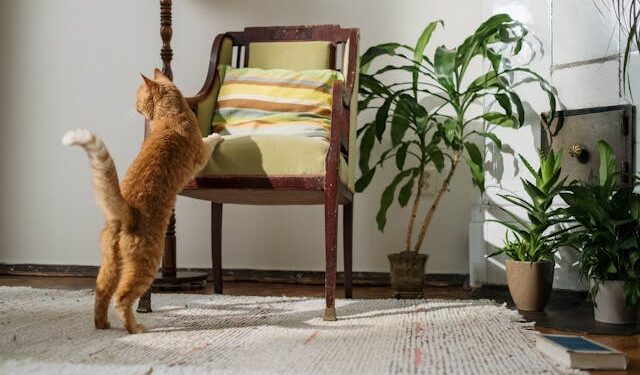If your cat is scratching your furniture, you’re not alone. This is a common issue among cat owners, but the good news is that you can train your cat to stop scratching where they shouldn’t. Scratching is a natural behavior, so rather than trying to eliminate it, the goal is to redirect it to appropriate surfaces. In this guide, we’ll explore why cats scratch and the best ways to prevent furniture damage while keeping your cat happy.
Why Do Cats Scratch Furniture?
Before learning how to stop your cat from scratching furniture, it’s essential to understand why they do it in the first place. Cats scratch for several reasons:
- Marking Territory: Scratching leaves both visual marks and scent signals from the glands in their paws.
- Claw Maintenance: Scratching helps remove dead layers from their claws, keeping them sharp and healthy.
- Stretching and Exercise: It’s a great way for cats to stretch their muscles and relieve stress.
Since scratching is an instinctive behavior, the best approach is to provide acceptable alternatives rather than trying to stop it completely.
Provide Alternative Scratching Surfaces
One of the most effective ways to prevent furniture damage is to give your cat a better option for scratching. Choosing the best scratching posts for cats can make a huge difference. Here’s what to consider:
- Material: Cats prefer sisal, cardboard, or wood for scratching. Avoid posts with smooth or flimsy materials.
- Height and Stability: A scratching post should be tall enough for your cat to stretch fully and sturdy enough to stay in place.
- Variety: Some cats prefer vertical posts, while others like horizontal scratching pads. Try different options to see what your cat enjoys.
Placement Matters
Even the best scratching post won’t work if it’s in the wrong location. Place it near the furniture your cat scratches most or in their favorite lounging areas. Reward them with treats when they use the post to reinforce positive behavior.
Use Cat Scratching Deterrents
If your cat keeps scratching your furniture despite having a scratching post, you may need to make the furniture less appealing. Here are some cat scratching deterrents that can help:
- Anti-Scratch Sprays: These sprays use scents that cats dislike, making them avoid certain areas.
- Double-Sided Tape: Sticky surfaces discourage scratching since cats don’t like the texture on their paws.
- Furniture Covers: Temporary protective covers can help while your cat learns to use their scratching post.
Training Your Cat to Stop Scratching Furniture
Training your cat requires patience and consistency. Here are some steps to help guide their behavior:
- Redirect Scratching Behavior: If you catch your cat scratching furniture, gently move them to the scratching post instead.
- Reward Positive Actions: Give treats and praise when they use the post to encourage continued use.
- Stay Consistent: Avoid punishing your cat, as it can lead to stress and confusion. Instead, focus on reinforcing good habits.
Keeping Your Cat’s Claws in Check
Regular claw maintenance can help reduce furniture damage. Here are a few ways to manage your cat’s claws:
- Nail Trimming: Trim your cat’s nails every few weeks to minimize sharpness.
- Soft Claw Caps: These are small, non-toxic caps that cover the claws to prevent scratching damage.
- Provide a Claw Care Routine: Regularly checking and trimming your cat’s claws will keep them comfortable and less likely to scratch excessively.
Environmental Enrichment and Play
Sometimes, excessive scratching is due to boredom or stress. Keeping your cat engaged with interactive toys and regular playtime can prevent destructive behavior.
- Interactive Toys: Puzzle feeders and wand toys can keep your cat mentally stimulated.
- Daily Playtime: Spending at least 15-30 minutes playing with your cat can reduce stress and prevent unwanted scratching.
- A Stress-Free Environment: Ensure your cat has enough space, hiding spots, and a comfortable place to rest.
Common Mistakes to Avoid
When trying to stop your cat from scratching furniture, avoid these common mistakes:
- Punishing Your Cat: Yelling or spraying water can make your cat fearful without stopping the behavior.
- Declawing: This is a painful and harmful procedure that should never be considered.
- Ignoring the Behavior: If your cat is scratching furniture, take action early to redirect their behavior before it becomes a habit.
Conclusion
Understanding why cats scratch and providing them with proper alternatives is key to protecting your furniture. By using scratching posts, deterrents, and positive reinforcement, you can train your cat while keeping them happy and healthy.





